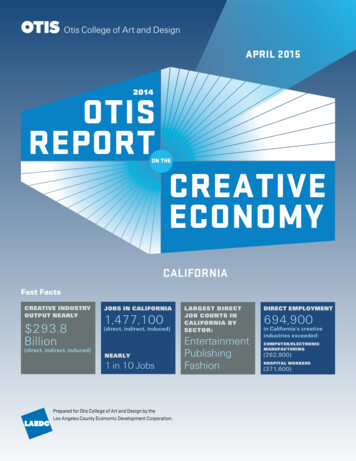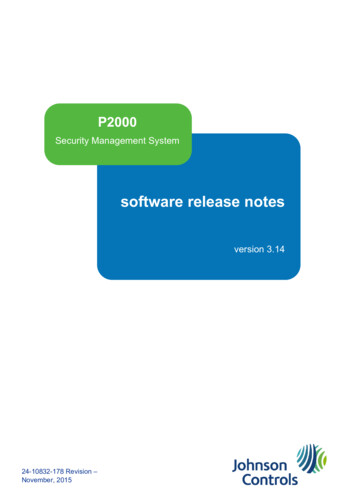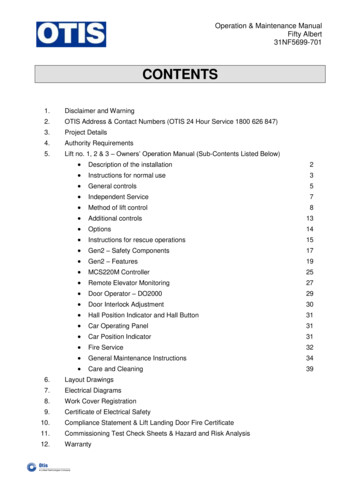
Transcription
APRIL 2015CALIFORNIAFast FactsCREATIVE INDUSTRYOUTPUT NEARLYJOBS IN CALIFORNIA1,477,100(direct, indirect, induced) 293.8Billion(direct, indirect, induced)NEARLY1 in 10 JobsPrepared for Otis College of Art and Design by theLos Angeles County Economic Development Corporation.LARGEST DIRECTJOB COUNTS INCALIFORNIA BYSECTOR:DIRECT LECTRONICMANUFACTURING694,900in California's creativeindustries exceeded:(262,900)HOSPITAL WORKERS(371,600)
outlined below and, based on the requirements provided in your limited use agreement, may requirereview and approval from a Boeing focal identified in your agreement prior to distribution orpublication.THANK YOUFormatThe Boeing signature consists of the Boeing symbol and logotype (the Boeing name in Stratotypeletters) combined in a fixed arrangement. The authorized electronic art files contain the proper formof the signature. The signature must be used in the prescribed colors and sizes with recommendedclear space and backgrounds.MEDIA PARTNERSDon't separate the components of the Boeing signature or use them in isolation.SPONSORSRemember:CA2014 Otis Report on the Creative Economy of CaliforniaONOMIC CONTRIBUTIONwww.otis.edu/otisreport2
2014 Otis Report on theCreative Economy of CaliforniaPrepared for Otis College of Art and Design by theLos Angeles County Economic Development Corporation.CA2014 Otis Report on the Creative Economy of CaliforniaONOMIC CONTRIBUTIONwww.otis.edu/otisreport
PREPARED AND RESEARCHED BY:PROJECT MANAGED BY:The LAEDC Kyser Center for Economic ResearchRobert A. Kleinhenz, Ph.D.Chief EconomistOtis College of Art and DesignArleen ChikamiAssistant Director of Strategic PartnershipsKimberly Ritter-MartinezEconomistClaudia Beinkinstadt KrumlaufDevelopment & Special Events ManagerGeorge EntisResearch AnalystRachel MoreauCoordinator, Strategic PartnershipsThe LAEDC Institute for Applied EconomicsChristine Cooper, Ph.D.Vice PresidentLinda JohnsonExecutive AssistantMatthew TecleCommunity Relations ManagerAnne Swett-PredockCreative DirectionJody Work ’13 MFADesign and ProductionDownload the full report, viewhighlights from the creativeeconomy launch event, and learnmore about other resources atwww.otis.edu/otisreportCA2014 Otis Report on the Creative Economy of the Los Angeles RegionONOMIC CONTRIBUTIONwww.otis.edu/otisreport4
REPORT CONTENTSIIntroductionKey Findings610II2014 Otis Reporton the Creative Economyof California12IIIHow to Use this ReportStatistical AppendixIndex of TablesSourcesCA2014 Otis Report on the Creative Economy of CaliforniaONOMIC CONTRIBUTION58617071www.otis.edu/otisreport5
KERRY WALK, Ph.D.INTERIM PRESIDENTOTIS COLLEGE OF ART AND DESIGNWhat is the economic impact ofcreativity?In 2007, President Samuel Hoi ofOtis College of Art and Design setout to answer this question bycommissioning the Los AngelesCounty Economic DevelopmentCorporation (LAEDC) to measure,benchmark, and assess trends inthe creative economy of the LosAngeles region, which comprisesL.A. and Orange Counties.CA2014 Otis Report on the Creative Economy of CaliforniaONOMIC CONTRIBUTIONwww.otis.edu/otisreport6
OTIS INTRODUCTIONBeginning last year, with thegenerous support of the CaliforniaArts Council, the economic analysiswas extended to the entire state ofCalifornia, long recognized as aglobal magnet for creativity andinnovation.Today, the annual Otis Report on the Creative Economy of the Los Angeles Region and California is aleading advocacy tool for the arts, design, and entertainment and has stimulated similar efforts incities and regions across the country. By capturing the size and role of the creative economy bothregionally and statewide, the expanded Otis Report has also inspired a convergence of cross-sectorleaders committed to working together toward the development of policies and the coordination ofresources that will allow the creative economy to flourish.The 2014 Otis Report, based on data from 2013, provides powerful and persuasive evidence of theenormous positive fiscal impact of the creative industries across California. Here are a few highlightsof the 2014 Otis Report related specifically to the state as a whole:Creative industry output totaled 293.8 billion (direct, indirect, and induced).The creative industries generated:1,447,100 jobs (direct, indirect, and induced), or nearly one in 10 of all wage andsalary employment, 113.5 billion in total labor income, and 12.1 billion in taxes to California state and local governments.The largest direct job counts by creative sector in California were entertainment(164,000), publishing and printing (131,200), and fashion (120,100).Direct employment in California’s creative industries (694,900) was more than two and ahalf times the number of workers that are employed by the computer and electronicmanufacturing sector (262,900) and nearly twice the number who work in California’shospitals (371,600).CA2014 Otis Report on the Creative Economy of CaliforniaONOMIC CONTRIBUTIONwww.otis.edu/otisreport7
OTIS INTRODUCTIONNew to this year’s report is the Location Quotient, a measure that seeks to quantifythe concentration of a particular industry, industry cluster, occupation, ordemographic group in a region compared to the nation. The Location Quotient revealswhat makes a region unique and gives an indication of where a region has acompetitive advantage. Amazingly, in 2013 in California, six out of ten occupationswith the highest Location Quotients were all creative occupations: actors, mediaand communications workers, makeup artists, film and video editors, media andcommunications equipment workers, and agents and managers of artists,performers, and athletes.If the original impulse of the Otis Report was to translate creativity into the hardnosed language of dollars and cents, this year’s report has come full circle with anattempt to tell the rich stories behind the statistics. To do this, Otis partnered withKCETLink and its award-winning Artbound series on a set of online articles and shortvideo segments. The project culminated with “The State of Creativity: A Look into theOtis Report on the Creative Economy,” a one-hour television special that premieredin Southern California on March 24th on KCET and nationally on March 30th at 8:00pm on Link TV. The television special and accompanying articles and video segmentsnow live on Artbound’s website, at www.kcet.org/arts/artbound, with the goal ofdeepening engagement with the Otis Report and enhancing its ability to reach newaudiences.The Otis Report can leave no doubt that creativity is a powerful economic driver bothregionally and statewide. KCETLink’s compelling portrayal of the faces and facets ofthe creative economy make a persuasive case for the beneficial and essential rolethat creative enterprise plays in our lives: it is central to the health and well-being ofour citizens and communities; it motivates innovation and ensures long-termregional competitiveness; and it creates jobs—numerous highly skilled jobs thatrequire significant preparation (often a Bachelor’s Degree or higher) to gain entrylevel employment.Now more than ever, it is critical that leaders from the public, private, and nonprofitsectors work together to develop and sustain the talent pipeline that feeds thecreative economy of our region. A necessary first step is investment in accessible,high-quality arts education, but championing policies and practices that encouragecreative placemaking, entrepreneurship, and innovation are also required for growingthe talent pipeline.CA2014 Otis Report on the Creative Economy of CaliforniaONOMIC CONTRIBUTIONwww.otis.edu/otisreport8
The 2014 Otis Report on the Creative Economy would not have been possible withoutthe generous support of individuals and organizations that have joined together toaffirm the value of the creative economy. On behalf of Otis College of Art and Design, Iwould like to express thanks to the Kyser Center for Economic Research at the LosAngeles County Economic Development Corporation for generating the Otis Report,and to KCETLink’s Artbound for bringing it to life through print pieces, video segments, and the television special “The State of Creativity: A Look into the Otis Reporton the Creative Economy.”OTIS INTRODUCTIONACKNOWLEDGMENTSI would also like to thank our lead sponsors, the California Arts Council and Mattel,whose support of the Otis Report has been vital and steadfast. Their commitment,and the generous contributions of the following supporters, have made the 2014 OtisReport and its release events in Los Angeles and Orange County possible: the BoeingCompany, the City of Los Angeles’ Department of Cultural Affairs, City National Bank,Hybrid Apparel, the James Irvine Foundation, and Sony Pictures. Media partners forthe events include KCETLink, Artbound, Arts for LA, Arts Orange County, Californiansfor the Arts, and LAX Coastal Chamber of Commerce.I conclude with the hope that this year’s transmedia presentation of the Otis Reportinspires creative stakeholders to continue to work together to heighten awareness ofthe social, cultural, and economic impact of the serious business of creativitythroughout California.Kerry Walk, Ph.D.Interim PresidentOtis College of Art and DesignOtis prepares diverse students of art and design to enrich our world through their creativity, their skill, and their vision.The College offers an interdisciplinary education for approximately 1,200 full-time students, awarding BFA degreesin Architecture/Landscape/Interiors, Communication Arts, Digital Media, Fashion Design, Fine Arts, Product Design,and Toy Design, and MFA degrees in Fine Arts, Graphic Design, Public Practice, and Writing. Through ContinuingEducation & Pre-College Programs, Otis offers a wide range of art and design courses and programs for all ages,including children and teens. For information, visit www.otis.edu.CA2014 Otis Report on the Creative Economy of CaliforniaONOMIC CONTRIBUTIONwww.otis.edu/otisreport9
KEY FINDINGSCAECONOMIC CONTRIBUTIONCALIFORNIA, 2013TOTAL GROSSSTATE PRODUCT 2.2 TRILLIONCREATIVE INDUSTRYVALUE- ADDEDCONTRIBUTION8.1%TOTAL CREATIVEINDUSTRY OUTPUT 294 BILLIONDirect, indirect, andinduced impactRevenues Spending Economic ActivityTax Revenues 12.1 BILLIONCA2014 Otis Report on the Creative Economy of CaliforniaONOMIC CONTRIBUTIONwww.otis.edu/otisreport10
KEY FINDINGSCAEMPLOYMENTCALIFORNIA, 2013NUMBER OFCREATIVEINDUSTRY JOBSDirect, Indirect,and Induced Jobs1.4 MillionWage and Salary WorkersDirect Jobs694,900Creative IndustryJobs Account for9.6%of all workersin CaliforniaCA2014 Otis Report on the Creative Economy of CaliforniaONOMIC CONTRIBUTIONwww.otis.edu/otisreport11
2014 OTIS REPORTON THECREATIVE ECONOMYOF CALIFORNIACA2014 Otis Report on the Creative Economy of CaliforniaONOMIC CONTRIBUTIONwww.otis.edu/otisreport12
About the Kyser Center for Economic ResearchThe Kyser Center for Economic Research was named in November 2007 in honor ofthe LAEDC’s first Chief Economist, Jack Kyser. The Kyser Center’s economic researchencompasses the Southern California region, which includes: the counties of LosAngeles, Orange, Riverside, San Bernardino, San Diego and Ventura. The center alsotracks developments and produces forecasts, studies, and reports on the California,national and international economies.The economy of the greater Los Angeles region is driven by more than its famedentertainment industry. The region’s broad economic base also includes aerospace,automotive, biotechnology, fashion, manufacturing and international trade. TheKyser Center conducts research on the individual industries of the region to betterunderstand ongoing changes in the economy.The Kyser Center is highly regarded for its accurate and unbiased assessmentof the economy. Kyser Center economists are also sought-after public speakersand frequent contributors to media coverage of the economy. At the heart of theKyser Center is its mission to provide information, insights and perspectives tohelp business leaders, government officials and the general public understandand take advantage of emerging trends. 2014 Los Angeles County Economic Development CorporationThe Kyser Center for Economic Research444 S. Flower St., 37th Floor, Los Angeles, CA 90071Tel: 213-622-4300, 888-4-LAEDC-1 Fax: 213-622-7100www.LAEDC.org research@laedc.orgPrepared for Otis College of Art and Design by theLos Angeles County Economic Development Corporation.CA2014 Otis Report on the Creative Economy of CaliforniaONOMIC CONTRIBUTIONwww.otis.edu/otisreport13
CONTENTSCALIFORNIAThe Creative Economy of CaliforniaNational and Global Economic ContextEconomic Contribution of the Creative IndustriesEmployment TrendsCounting the Self-EmployedOccupations in the Creative EconomyLooking Ahead: The Creative Economy in 2018Industry SnapshotsArchitecture and Interior DesignArt GalleriesCommunication ArtsDigital MediaEntertainmentFashionFurniture and Decorative ArtsProduct and Industrial DesignPublishing and PrintingToysVisual and Performing ArtsNonprofit Segment of the Creative EconomyK-12 Arts EducationHow to Use This ReportNotes on Methodology and DataStatistical AppendixIndex of TablesSourcesCA2014 Otis Report on the Creative Economy of CaliforniaONOMIC 50545860617071www.otis.edu/otisreport14
THE CREATIVE ECONOMYOF CALIFORNIAHow is creativity defined? One definition is that “creativity is the ability to producesomething that is novel or original, and useful or adaptive.” This sounds simpleenough but how is that “something” achieved? The creative spark is often depicted asan “aha” or “eureka” experience, when the reality may have been that years ofthought, hard work and experimentation were needed to arrive at that one moment.1Researchers still cannot name the specific combination of biological and environmental factors that produce creative brains. Theories of the origin of human creativityare beyond the scope of this report, but if fostering creativity is to be considered as ameans of economic development, then one must ask if creativity can be learned ortaught, and if so, how it can then be nurtured.1Andreasen, Nancy.“Secrets of the Creative Brain”,The Atlantic; Web.June 25, 20142IbidA second question is whether or not creativity in the arts can be equated withcreativity in the sciences or in business, or should the latter two groups be consideredseparately? Is innovation in the sciences or business the same as artistic creativity oris it something altogether different? Research suggests that the process of creation(or innovation) in all three activities is largely the same: preparation, incubation,inspiration (the eureka moment) and production. The same, ongoing, iterativeprocess is essential to many forms of creativity whether it be composing anorchestral work or revealing the structure of the universe.2Creativity is one of California’s foremost economic assets and the creative economyis undeniably important to the region’s economic growth. In this report, the creativeeconomy is defined as the businesses and individuals involved in producing cultural,artistic, and design goods and services. It consists of creative professions andenterprises that take powerful, original ideas and transform them into practical andoften beautiful goods, or inspire us with their artistry.It also includes organizations that provide a venue for artists to share their work withthe public such as art galleries, festivals, museums, and theaters. Finally, the creativeeconomy includes activities one does not instinctively associate with creativity suchas apparel, toy and furniture manufacturing - all industries that depend on gooddesign.CA2014 Otis Report on the Creative Economy of CaliforniaONOMIC CONTRIBUTIONwww.otis.edu/otisreport15
In a broader sense, the creative economy must include a support system thatteaches, nurtures and sustains creative activity: arts programs in K-12 schools,post-secondary arts institutions to develop talent, and philanthropic foundationsalong with the other nonprofit funding organizations to provide financialresources, incentives, and services to the creative arts.In today’s economy, the market value of products and services is increasinglydetermined by a product’s uniqueness, performance and aesthetic appeal. Morecompanies are seeking employees with creativity as well as problem solving andcommunication skills. Business location decisions are also influenced by factorssuch as the availability of a creative workforce and the quality of life available toemployees. The talent that drives the creative economy provides a competitiveadvantage that reaches across almost every industry in California.Firms develop a competitive advantage when they implement strategies thatother firms cannot duplicate. Regions acquire a competitive advantage when theyattract creative employees because creative thinkers encourage innovationwhich fosters economic growth. Furthermore, the creative talent pool in a region isnot as vulnerable to going “offshore”. Historically, the development of advancedtechnologies that increased productivity was seen as a pathway to better jobs, butthat is no longer necessarily true. Many advanced technologies can be replicatedacross the world using cheaper labor. But original artistic creation, innovative designand other higher-level creative work cannot be outsourced so easily. Creativitybuilds both brand awareness and attracts talented people to a dynamic environment.Moreover, cultural spaces can become hubs for civic engagement, often a powerfulcommunity revitalization asset, especially in economically distressed communities.Because creativity is a dynamic function of humanity, the creative economy isa vibrant and vital force in society. Intellectual and aesthetic sensibilities leadindividuals to express themselves through the arts, solve problems through design,and seek out what is beautiful and original. In many ways California is unique becauseof its combination of place, resources and open attitudes toward new ideas. Thisopenness to new ideas and the ability to make associations and connections thatother people do not see is one of the defining characteristics of creativity.Here, new ideas are constantly given form and brought to life by creative people.Otis College of Art and Design, a critical component of the creative economy,commissioned the analysis in this report to put real numbers to the business ofcreativity. Otis and the LAEDC carried out this research because in the state ofCalifornia, creativity is fundamental to economic growth and prosperity.CA2014 Otis Report on the Creative Economy of CaliforniaONOMIC CONTRIBUTIONwww.otis.edu/otisreport16
NATIONAL AND GLOBALECONOMIC CONTEXTWhile this report places the creative industries of California in the spotlight, thebackdrop for these industries is the overall national and global economy. This sectionbriefly summarizes recent and anticipated economic conditions.As 2014 drew to a close, growth of U.S. gross domestic product (GDP) was expected tomatch the previous year’s 2.2% rate. The U.S. economy should see continued forwardprogress in 2015 in both the public and private sectors. Even housing and construction, which came in below expectations in 2014, should move to higher levels in 2015.GDP growth is expected to accelerate to 2.9% in 2015. The faster pace of economicgrowth will support continued job gains across most sectors of the economy,pushing the unemployment rate down to the natural rate of unemployment (i.e.full-employment) of roughly 5.5%. It should also be a year of stronger wage gainsas the labor market tightens. Job gains and higher wages will support increasesin consumer spending, which should reach near-trend growth of 2.7% in inflationadjusted terms in 2015. Meanwhile, inflation itself, which has been tame over thepast few years, is likely to stay in check going forward.Business investment spending has grown consistently over the past five years, drivenlargely by spending on equipment, structures and intellectual property. Looking aheadto 2015, investment overall is expected to grow by 6.3% after a projected 5.8% gainin 2014.California matched or exceeded the nation in terms of economic growth over mostof the recovery period, enabling it to add jobs at a faster pace and recover from amore severe hit during the recession. With improvements across much of the state,California will outpace the nation’s growth over the next five years, both in termsof real gross product, and wage and salary job growth. This will drive the state’sunemployment rate down to long-run normal levels. Personal income, which hasimproved during the last several years, will grow more quickly going forward.CA2014 Otis Report on the Creative Economy of CaliforniaONOMIC CONTRIBUTIONwww.otis.edu/otisreport17
While modest steady growth is expected for the nation and California over the nextyear, there are risks to the forecast, primarily from elsewhere in the world. The nation’smajor trading partners across the Atlantic and the Pacific have struggled to ignitesustained growth within their economies. One could argue that policy missteps oromissions are to blame, but political developments in Ukraine, the Middle East, andelsewhere around the globe have increased both political and economic uncertainty,never friends of economic growth.The global economy always faces risks associated with disruptions to the supply ofenergy, but these risks are low at this time. Energy price spikes pose less of a directthreat to the U.S. economy because of increases in domestic energy production. Eventhe indirect threat is reduced at this time because of the cooling effect on globalenergy prices of current economic weakness among U.S. trading partners.ECONOMIC CONTRIBUTIONOF THE CREATIVEINDUSTRIESEMPLOYMENTA total of 694,900 wage and salary workers in California were employed directlyin the creative industries in 2013. By sector, the largest employment counts were inentertainment (164,000 jobs); publishing and printing (131,200 jobs); and fashion(120,100 jobs). Together, these three industries accounted for nearly 60 percent ofdirect creative industries employment in California.Direct employmentin California’s creativeindustries (694,900)was more than two andhalf times the numberof workers that areemployed by the computerand electronic manufacturing sector (262,900)and nearly twice thenumber who work inCalifornia’s hospitals(371,600).Source:California EmploymentDevelopment Department,Labor Market InformationDivision.While the direct job counts are impressive, they are only one part of a much largeremployment picture. Direct employees are those who actually work in the creativeindustries of California. Indirect jobs are created when firms in these industries makepurchases from their suppliers and vendors. Additional induced jobs are generatedwhen the direct and indirect employees spend their wages on consumer goods andservices. In that sense, every job across the creative sector supports or sustainsother jobs in the state.CA2014 Otis Report on the Creative Economy of CaliforniaONOMIC CONTRIBUTIONwww.otis.edu/otisreport18
Direct, indirect and induced employment in the creative industries of California totaledover 1.4 million jobs in 2013. The ripple effect is substantial, giving rise to job gainsand increases in incomes in a wide range of industries across the state’s economy.TABLE 1:Employment Impact of theCreative Industries, 2013DIRECT JOBSINDIRECT &INDUCED JOBSTOTAL JOBS694,900752,2001,447,100LABOR INCOMETotal direct labor income in the creative industries of California amounted to 71.4billion in 2013. Examining the distribution of labor income across the creative economyprovides a sense of how individual creative industries compare in size and economiccontribution.At 23.4 billion, the publishing and printing sector contributed the largest share(32.7%) to total creative industry payrolls in California. Entertainment was secondwith 16.6 billion or 23.2%, followed by digital media at 8.8 billion (12.4%).Although labor income earned by individuals directly employed in the creativeindustries of California was 71.4 billion, the total combined effect of adding indirectand induced workers brought that figure up to 113.5 billion.CA2014 Otis Report on the Creative Economy of CaliforniaONOMIC CONTRIBUTIONwww.otis.edu/otisreport19
DIRECT LABOR INCOME OF THEDIRECTLABORINCOME INOFCALIFORNIA,THECREATIVEINDUSTRIES2013CREATIVE INDUSTRIES IN CALIFORNIA, 20134%4.4% 4%5.2%4.4%1.1% .4% .3%1.1% .4% .3% .1%.1%5.2%CALIFORNIADIRECT LABORINCOMECALIFORNIADIRECT LABOR INCOME32.7%7.1%32.7%7.1%9.2%9.2%12.4% 71.4 Billion 71.4 Billion12.4%Source: California EDD,QCEW 1%23.2%23.2%Publishing & PrintingEntertainmentPublishing & PrintingDigitalMediaEntertainmentVisualPerforming ArtsDigital &MediaFashionVisual & Performing ArtsCommunication ArtsFashionFurniture & DecorativeCommunicationArts ArtsArchitecture& Interior DesignFurniture & DecorativeArtsToysArchitecture & Interior DesignPerformingArts SchoolsToysProduct& IndustrialDesignPerformingArts SchoolsArtGalleriesProduct& Industrial DesignArt GalleriesSee the Industry Snapshots section of this report for the direct, indirect and inducedlabor income effects of individual industry sectors.TAX EFFECTSActivity in the creative sectors triggers jobs and spending, but it also results in taxrevenues for state and local government. As with jobs, there is a ripple effect with taxrevenues because the initial direct effects give rise to indirect and induced effects.The LAEDC calculated tax effects attributable directly and indirectly to the creativeindustries, including property tax, state and local income tax, and sales tax revenues.CA2014 Otis Report on the Creative Economy of CaliforniaONOMIC CONTRIBUTIONwww.otis.edu/otisreport20
In California, property taxes, state and local personal income, and sales taxesgenerated directly and indirectly by creative industries were nearly 12.1 billion in2013. By sector, publishing and printing generated tax revenues of 2.5 billion,followed by fashion at 2.4 billion and entertainment at 2.3 billion.ECONOMIC CONTRIBUTIONSUMMARYTable 2 summarizes the total economic contribution of California’s creative industries in 2013. The creative industries generated 293.8 billion in direct, indirect, andinduced output. They employed over 1.4 million wage and salary workers who earnedtotal income of 113.5 billion. The nonemployer establishments are excluded fromthe contribution analysis (direct, indirect and induced) in part because they are froma different year, and also to avoid double counting (an individual may do both contract work and be on a company payroll). However this figure shows that significantnumbers of workers are employed as freelance/contingent workers over and abovethe wage and salary jobs that are a part of the formal contribution analysis.Direct, indirect and induced workers paid 12.1 billion in taxes to California stateand local governments. Of the 293.8 billion in total creative industries output, 179.0 billion was value-added (labor income and profits) generated by the creativeindustries in excess of materials and services purchases. This net economiccontribution of 179.0 billion was the equivalent of 8.1% of the region’s grossproduct of 2.2 trillion in 2013.33The contribution of the creativeindustries to California’seconomy increased over theyear. In 2012, the creativeindustries value-added was 155 billion, which equated to7.8% of California’s grossproduct of 2.0 trillion.TABLE 2:Economic Contribution of the CreativeIndustries, 2013CADIRECT IMPACTTOTAL IMPACTJOBS: 694,900DIRECT & INDIRECT JOBS: 1,447,100NONEMPLOYER ESTABLISHMENTS(most current data from tax year 2012, IRS):316,383OUTPUT: 293.8 BillionLABOR INCOME: 71.4 BillionTAXES: 12.1 Billion2014 Otis Report on the Creative Economy of CaliforniaONOMIC CONTRIBUTIONLABOR INCOME: 113.5 Billionwww.otis.edu/otisreport21
EMPLOYMENT TRENDSDirect employment in California’s creative industries peaked in 2006, contractedsharply during the recession and continued to fall during the early years of therecovery. Five years have elapsed since the end of the recession, and while jobcounts have improved, employment in the creative industries has yet to fully recover.This pattern has not been confined to the creative industries, but is also true of totalpayroll employment in the state. The five-year comparisons (2008-2013), which arethe focus of this report, encompass the full employment effects of the recessionthat occurred from 2008 to 2010. However, the creative industries took a bigger hitrelative to the economy as a whole. Between 2008 and 2013, California suffered aloss of 58,400 jobs in the creative industries, a decline of 7.8%. By comparison, thetotal number of nonfarm jobs across all industries in the state fell by just 0.6%.Although the recession and slow recovery accounts for much of the decline in jobsover the last five years, the larger drop in creative industries employment relative tothe overall economy can be explained in large part by the disproportionate share ofmanufacturing jobs that are included in the creative economy. In 2013, manufacturingjobs were 8.3% of total nonfarm employment in California. Between 2008 and2013, job counts in the state’s overall manufacturing sector declined by 12.2%. Incontrast, manufacturing jobs in the creative industries comprised 24.6% of creativesector employment. The decline in creative sector manufacturing jobs over thatsame five year period was 22.3%. The greater decline in creative sector manufacturingstems from the fact that production jobs in apparel and furniture manufacturingcontinued to be outsourced to lower-cost countries.Som
innovation. Today, the annual Otis . Amazingly, in 2013 in California, six out of ten occupations with the highest Location Quotients were all creative occupations: actors, media and communications workers, makeup artists, film and video editors, media and . KCETLink’s compell










